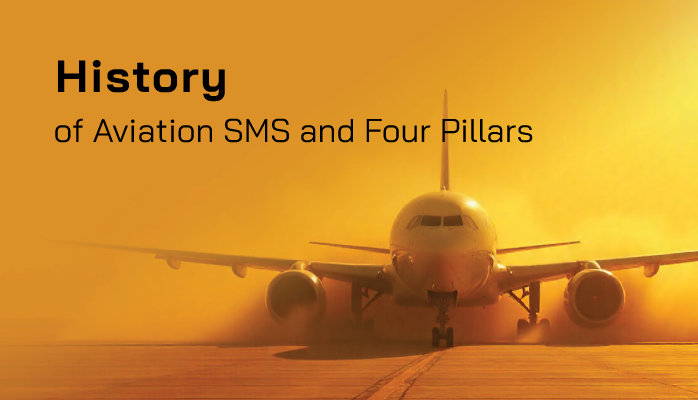Overview of SMS History

It’s easy to forget just how young aviation safety management systems (SMS) are as their own defined entity. Aviation SMS has truly changed the aviation landscape, but there will certainly be more change as organizations reduce resistance to the change and continue to internalize and practice the mandated SMS regulations.
Many of the central tenets of modern aviation SMS go back much further in history, but as a cohesive whole, 2016 will mark only the end of the first decade for formally solidified SMS in the United States and worldwide.
Related Aviation SMS Implementation Articles
- Why Should We Implement Aviation SMS?
- Is Your Aviation SMS Implementation a Farce? - With Self Assessments
- How to Start an Aviation SMS Implementation - With Resources
Tracing the origins of such a colossal safety framework is tough because of:
- So many different influences;
- Differing interpretations; and
- Differing timelines in different countries.
Moreover, it’s clear that in the history of aviation SMS, there is no specific beginning time, but rather is the subject of an evolutionary process, with various combinations and influences from other management fields, such as ISO 9000's quality management systems. Nonetheless, there are some major milestones in the 50 years of SMS, from various influences and roots to what we formally call aviation SMS today.
Differing Perspectives of Viewing Aviation SMS
We can consider an aviation SMS as a broad spectrum framework of:
- Philosophy
- Tool set
- Methodology
- Approach
What also seems clear is that aviation SMS is not only the long-term plan and future of the aviation safety industry but also other industries as well.
Quality Management Systems (QMS) Roots

Many of the modern concepts of safety in aviation SMS can be found in safety system concepts from the 60s and 70s, and largely from other management systems (i.e. quality management systems (9000 series) and environmental management systems (14000 series)).
There are many overlaps between the structure of QMS and SMS. Current SMS concepts stress a similar approach towards reaching similar end goals as ISO-9000: they both use a-
- Structured
- Documented
- Process
-the approach towards reaching their respective goals.
In the 1980's several authorities, such as the New Zealand Internal Quality Assurance and European Joint Aviation Authority (now replaced by EASA), both required that their quality management systems incorporated oversight of an accident prevention program. The Federal Aviation Administration quickly followed suit as well.
Before this, the standard safety improvement model was totally reactionary.
- Wait for an accident
- Investigate it to see what went wrong
- Make changes to avoid the same accident in the future
I may be going out on a limb in saying this, but I believe that the principle in QMS of *preparing* for creating a quality system was the initial inspiration for SMS’ concept of hazard identification and risk management processes.
Even if that isn’t true, it’s impossible to ignore, both from historical evidence with EASA, the FAA, and other authorities, as well as from the system theory shared by both SMS and QMS, that aviation SMS was initially sparked as an offshoot of QMS principles. Of course, aviation SMS would quickly go through some pretty radical changes to distinguish itself from QMS.
When one considers the QMS requirements for an ISO 9001 compliant company, one is left with no doubt that aviation SMS requirements are derived from the ISO 9000 framework.
Related Aviation Hazard Identification Articles
- 4 Pillars | What Is Hazard Identification in Aviation SMS
- Understanding Role of Hazard Identification Training and Safety Reporting Forms in Aviation SMS
- 4 Tips to Approach Hazard Identification in Aviation SMS
Turning Point for Aviation SMS
Fast forward about 10 or 15 years after various aviation authorities started looking into incorporating safety oversight into their QMS programs. It’s the 1995 aviation safety summit that includes 950 representatives from airlines, unions, regulators, and various other aviation organizational denominations.
1995 would prove to be a turning point for aviation SMS branching into its own discipline. For one, the FAA’s Administrator, David Hinson, worked to cooperate on reaching a goal of 0 accidents. Perhaps this was the first, large-scale, international “proactive” safety meeting, as in, projecting forward with common goals.
The 2-day meeting resulted in three things:
- Identification of 540 “issues” by the various delegates
- FAA creation of a new Office of System Safety
- An FAA issued an Aviation Safety Action Plan with 173 initiatives
Again, as said, words like “plan” and “initiative” are simply variations of “proactive.” The difference between this and the past is rather striking: it’s the difference between basing standards on a current plan and future goals, versus basing standards on past accidents.
Such an approach has turned out to be the logical step before current SMS concerns, which, rather than focusing on the specific accident, are more concerned with the precursors for an event. Precursors are the tools of proactive and predictive SMS because they identify risks before the risks have actually materialized.
Related Aviation Risk Management Articles
- What Is the Process of Risk Management in Aviation SMS
- 4 Critical Elements of the Aviation SMS Risk Management Process
- Most Common Aviation Risk Management Challenges at Airlines & Airports
Four Pillars of SMS
In a previous article on the history of the 4 Pillars of Aviation Safety, Steve Corrie offered great detail on the history of the Four Pillars. The Four Pillars of SMS-
-would turn out to play a decisive role in carrying SMS from an "FAA department" and “action plan” to a full-fledged system structure on par with QMS.
Incidentally, the Four Pillars of SMS originated with James P. Steward, the former director of Transport Canada. The Air Line Pilots Association (ALPA), Int’l, developed its SMS around the Four Pillars in the year 2000.
It would be from the work of ALPA, Int’l that such authorities as the FAA and International Civil Aviation Organization (ICAO) would adopt the 4 pillars framework.
2006 the Big Year for Aviation Safety

Just a few years later, the stage was set for modern versions of aviation SMS to start rolling out. That year ICAO began requiring member states' operators to develop and implement SMS for greater safety.
That same year, the FAA focused its SMS efforts toward its certificate holders:
- Aircraft operators
- Aircraft maintenance organizations
- Air navigation service providers
- Airport operators
Around the same time, authorities from other countries, such as Transport Canada; also committed to implementing aviation SMS. Today, we easily see that Australians and Canadians have left to become world leaders in aviation SMS implementations among their operators. I believe this is due to the decisive leadership and dedication of their civil aviation authorities.
From this point on, aviation SMS would continue to solidify as *the* method of safety in the aviation industry.
Related Aviation SMS Implementation Articles
- Your Top 4 Risks to Aviation Safety Management System Implementations
- 6 Questions & Downloads for Starting an Aviation SMS Implementation
- SMS First Steps - How to Create an SMS Implementation Plan
Final Thought: Coming Full Circle
In 2015, the final SMS rule passed legislation for FAA air carriers to have an SMS program in place by 2018. It is the final “nail in the coffin” so to speak for U.S. operators. It has been a long time to come, due primarily to the democratic nature of the United States legislative process.
The most important issues left regarding the “place” of aviation SMS going forward will be, in my opinion, the relationship between QMS and SMS. Judging from the number of comments, and interest in the relationship between these two areas, it’s quickly stepping onto the hot plate of consideration. Things like:
- Should SMS come full circle to its roots, and be fully integrated with QMS?
- Should SMS be absorbed under the greater umbrella of QMS
- Should both systems be managed separately, alongside each other?
The push seems at this point towards full integration. And why not? An operator who doesn't have a QMS may as well use the SMS to improve operational processes while complying with regulatory requirements. To me, it makes perfect sense. Operators may also benefit from QMS processes while they expend time and energy on their SMS implementations. This approach of dual implementation has efficiency and benefits the operator.
I expect to see more about these issues in the coming years.
Are you developing your aviation SMS implementation? Do you need to compare your hazard register with common aviation industry hazards? Download this excellent resource.
Last updated in September 2025.








